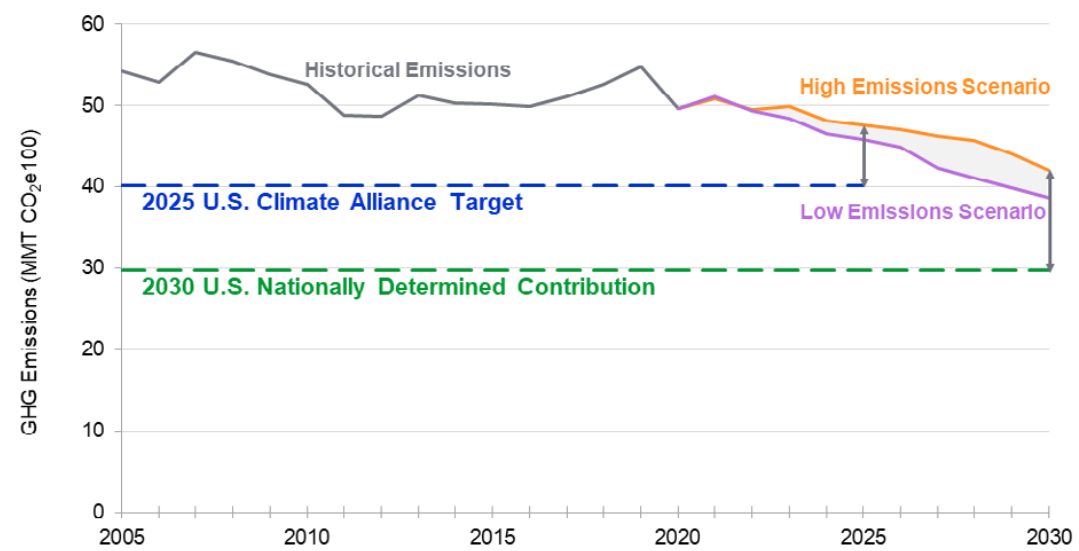Last legislative session, Oregon’s lawmakers had the opportunity to update Oregon’s statutory climate targets. This would have been the first time that Oregon updated its outdated climate targets in 15 years and would have brought Oregon’s climate goals in line with the level of ambition of President Biden’s national climate targets and from other climate leadership states.
But then, Oregon’s legislative session was stalled by a small group of state Senators who fled the Capitol instead of fulfilling their core responsibility as elected officials: to represent their constituents by casting votes in the legislative process. This walkout tactic has been used time and time again and has prevented climate action supported by a majority of Oregonians. This year’s walkouts — the longest in Oregon’s history — prevented Oregon from updating its climate goals.
Without updated climate goals in place, Oregon risks falling short of securing the greenhouse gas (GHG) emission reductions that are needed to avoid the most dangerous, irreversible impacts of climate change. Oregon has made important progress in regulating emissions, as one of the states leading the way on cutting pollution from the power sector, the transportation sector, and natural gas fuels — but new analysis by EDF has found that without additional action, Oregon is projected to fall short of achieving its climate commitments.
Here’s what to know about the analysis and next steps Oregon can take to raise the bar for climate action.
What does EDF’s emissions gap analysis show?
Twenty-four states, including Oregon, have made commitments to reduce greenhouse gas emissions as part of the U.S. Climate Alliance or through state-specific policies. To understand the progress made by these climate leadership states, EDF conducted an analysis based on data from Rhodium group comparing business-as-usual (BAU) emissions projections to each state’s climate commitments. These estimates are used to evaluate the emissions “gap” — the difference between state commitments to reduce emissions, and projected emissions under current state policy — through 2030.
EDF’s estimates include projected emissions reductions associated with all state policies in place as of June 2022 and include GHG abatement expected from both the federal Infrastructure Investment and Jobs Act (IIJA) and the Inflation Reduction Act (IRA). For Oregon, this includes critical policies and programs that are actively delivering emissions reductions, including Oregon’s Clean Energy Targets bill, which requires electric utilities to cut their emissions 80% from baseline levels by 2030, 90% by 2035, and 100% by 2040, and Oregon’s Climate Protection Program, which requires emissions from transportation fuels and natural gas fuels to be reduced 50% from baseline by 2035 and 90% by 2050.
But even with these important programs in place, EDF’s analysis found that Oregon is falling short of the level of climate ambition required to achieve emissions reductions at the pace and scale needed to avoid the most dangerous impacts of climate change. Here’s how EDF’s analysis projects Oregon’s emissions reductions will stack up against the President Biden’s national climate goals under the U.S. Nationally Determined Contribution (NDC) and the U.S. Climate Alliance’s 2025 target:
EDF’s analysis finds that Oregon will cut statewide emissions between 12% and 16% from 2005 levels by 2025, missing the 2025 U.S. Climate Alliance goal of a 26% reduction by 2025. The state is also projected to cut emissions between 23% and 29% from 2005 levels by 2030, missing the U.S. NDC goal of a 50% reduction by 2030. On top of this, Oregon is still 19% behind on achieving the state’s 2020 climate goal.
Oregon has made critical progress in reducing emissions, and every bit of avoided climate pollution is important — but the state still has an emissions gap, meaning that the state must continue to raise its ambition in order to follow through on its climate commitments.
How can Oregon close the emissions gap and turn its climate commitments into reality?
We’re at a critical moment in Oregon’s climate fight. The Oregon Health Authority recently released a report detailing how climate-related events are already adding strain to the state’s medical system, with heat-related illnesses and deaths becoming more and more frequent. Intensifying wildfires continue to impact lives and livelihoods — with approximately 1.3 million acres burned by wildfires in Oregon in 2021 and 2022, and an overall increase in cumulative smoke exposure. The science is clear that all pathways to a more stable climate involve rapid, deep and swift greenhouse gas emissions reductions in all sectors this decade.
Oregon has long been a leader on climate policy but needs to level up ambition to close the gap between projected emissions and the level of action we know is needed to protect the lives and livelihoods of Oregonians. Here’s how Oregon can close the gap:
- Use existing authority to heighten ambition and fill in the gaps in Oregon’s climate regulations. Oregon’s Department of Environmental Quality (DEQ) has broad authority to regulate greenhouse gas emissions to reduce pollution. That authority must be put to work to increase ambition and fill in the gaps in Oregon’s climate regulations. Through the Climate Protection Program (CPP), Oregon has placed a declining, enforceable cap on emissions from transportation fuels and natural gas fuels — but industrial sources are currently not required to achieve emissions reductions consistent with the CPP’s cap. This leaves Oregon’s climate future uncertain. Oregon’s regulators could act right now to make sure that industrial facilities are subject to emission reduction requirements consistent with the CPP’s declining cap — and Oregonians can act today to make their voices heard.
- Set updated climate targets that are binding and consistent with the emissions reductions that the science tells us are needed to avoid the most damaging climate impacts. Due to the walkouts during this year’s legislative session, updating Oregon’s climate targets remains unfinished business for the state and a missing piece in Oregon’s approach to climate policy. There are currently nine states with binding, economy-wide climate targets, including Oregon’s neighbors Washington and California. These binding climate targets are set in law and require quantifiable emissions reductions at the pace and scale needed to achieve the targets. Updated, mandatory climate targets would raise the level of ambition across Oregon’s climate policies and programs while providing certainty that polluters from all sectors of Oregon’s economy will be required to cut their pollution at the pace and scale required.
- Harness federal funding to boost climate action while supporting Oregon’s economy. Oregon has more opportunity than ever before to deliver rapid cuts in climate pollution, thanks to the $369 billion in climate and clean energy investments that are part of the federal Inflation Reduction Act. These investments will make decarbonization cheaper than ever before, allowing Oregon to lock in both climate and economic benefits in a cost-effective way. Oregon’s lawmakers passed the Climate Resilience Package in June, which will establish a program to help rural, tribal, and other environmental justice communities navigate federal funding opportunities. These types of programs and technical assistance will be critical for maximizing climate investments and ensuring that they provide benefits to communities on the front lines of climate and air pollution impacts.
Oregon needs a mandatory, coordinated approach to the climate crisis that provides certainty that polluters from all sectors of Oregon’s economy will cut emissions at the pace and scale needed to achieve our climate commitments. We need to protect and strengthen the policies and programs that Oregon currently has in place — but we also need to fill in gaps, and make sure that Oregon’s climate regulations are calibrated to level of ambition that’s needed to make critical climate goals a reality.



One Comment
Thank you for your article. Climatic changes should not be taken lightly